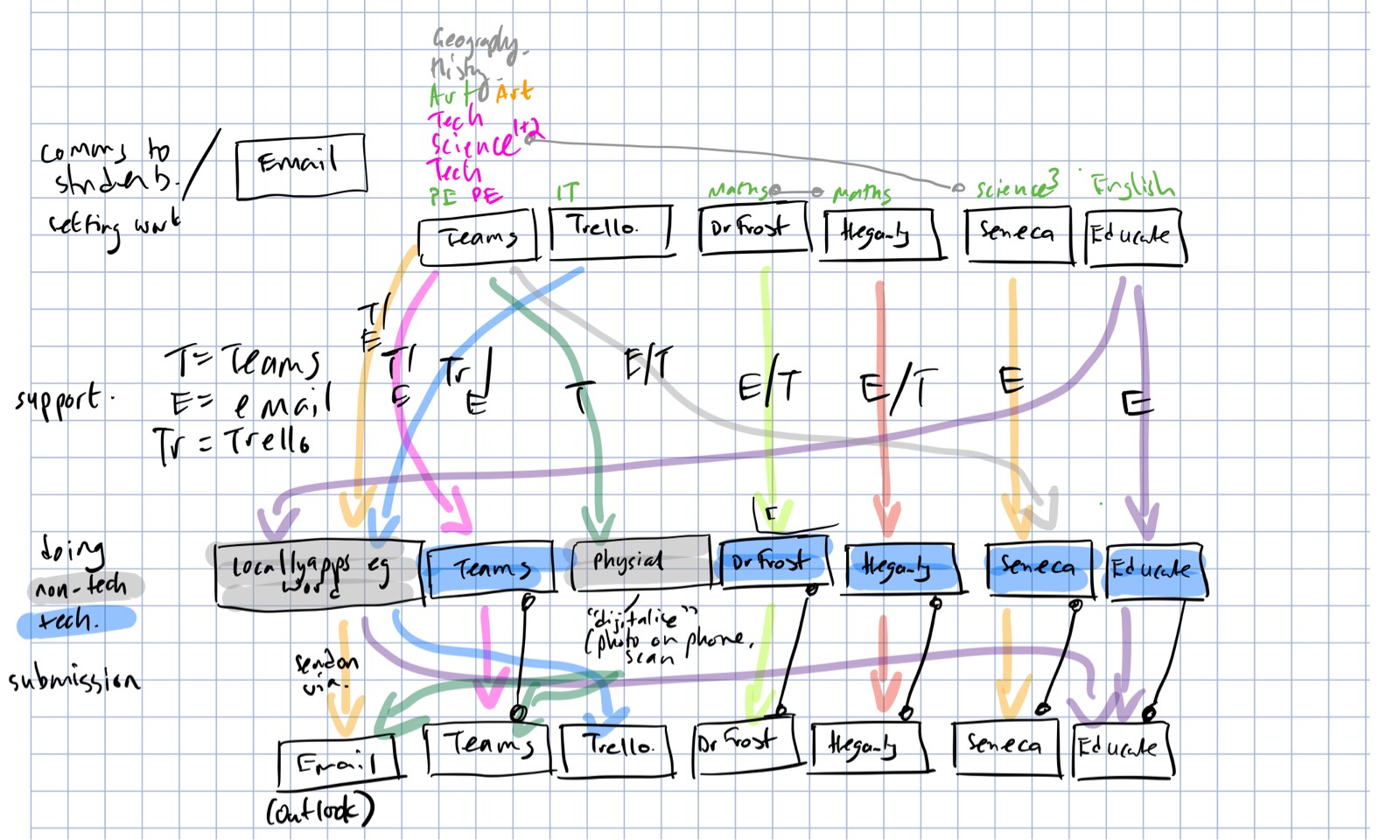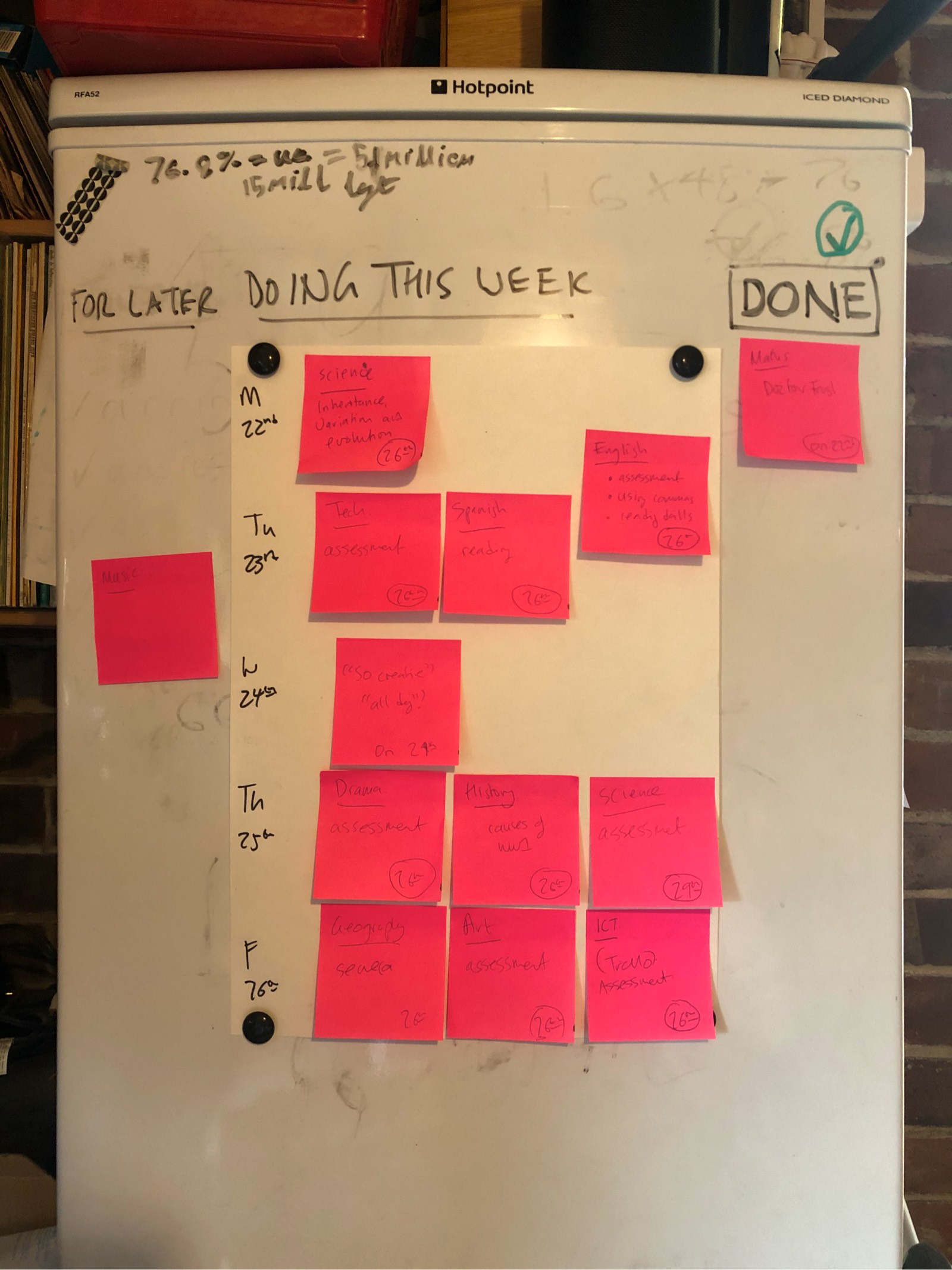How’s homeschooling been going for you?
Things heated up at my end a few weeks back when the amount of the boy’s schoolwork increased. We got access to an email address we could access online through Outlook, which led to access to Microsoft Teams. Then came a Trello board. Then access to Seneca. And then other things. As each subject was getting in touch separately with their process we were messily learning the what, the how and the when as we went along. I started to map it all lightly.
- For each subject, how does the boy find out what work he has been set?
- Where and how does he do the work? (Online: What system? Offline?)
- Support: What if the boy needs to talk to his teacher/s about the work?
- Submission: How is the work sent to the teacher/s?
- Feedback: How did he get on?

It’s all about assumptions as we go along.
An assumption that continues to be proven correct: Not every subject starts in the same place (on Teams).
An assumption that proved to be wrong early on: Each subject has one tool for doing the work. Incorrect. Maths had two. We had to update and adapt as we went along.
A series of digital tools for getting the work and knowing where to look for which subject was one thing.
If the boy was at school he would have been in a lesson in a classroom, noted down the details of any work in his journal and planned from that. It wasn’t perfect. We always had to check he wasn’t leaving it all to the last minute. Where is that sheet he needs to do the work? still happens in secondary school. But there was a process, a system even, and the journal was the record of his mind processing what was needed.
Gathering and analysis can be overlooked when we rush to digitalise processes. Long lists of things to do don’t help you as a person work through what you need to do and when by. You still need to order it. This can be overwhelming if you are given most things or every thing at once.
To help with this at the start of the week we have small session with a sticky note for every subject the boy studies. We look through the systems the lessons use and see what is needed. This means a look at — and that means a good look over — the work set. We see what is needed and write onto each subject sticky note:
- The subject.
- A brief description of the work. Not “work on Trello” but a brisk overview of the work, like “answer questions about rap”.
- Any deadline (sometimes there is a time on a day not just a day, such as 12pm on Friday; there have been several pieces of work that have to be done on a particular day).
Looking over the work gives us a rough idea of the size of the work, which we don’t record because it’d make the sticky notes too busy. We then put the stickies onto a sheet of A3, with a row for each day of the week. We try to have three subjects for each day (handily the paper width limits us to three), sometimes one or two more if they’re “smaller” pieces of work. As they are sticky notes we can move them around as much as we like. And once we are done doesn’t mean we are finished.
As we go through anything that is needed beyond the current week we place to the left of the paper, for later. As work is done the boy moves them over to the right of the paper, done, complete with a green tick because he thinks green is a positive colour that shows movement.

What subjects go where? That is very much down to the boy’s choosing, but a contributory factor is spreading about the lessons he likes less so there is no build up of them on any one day.
At the start of the day the boy takes the sticky notes and puts them on a picture frame. As the sticky notes are removed and placed under done on the fridge a message is revealed: No More Work.
Sometimes the boy hits blockers, he has a question and needs to speak to a teacher. Again there are various methods to contact the teachers, but it only three:
- By chat on Teams.
- By email.
- By comments on a Trello board (for one subject).
There is a wider variance is response though, some teachers are more immediately available, others we do not get a reply for several days. But the boy moves that sticky note onto another day. He also now tries to plan work with a slower response earlier in the week. Time is a thing we miss from so many process maps.
The boy is enjoying how he can move his work around to suit his… preferences, whether they are like/not-like for a subject, mood, difficulty, whatever. If he was at school his timetable would be more rigid. He also talks to his friends as they work and they align their work so they can do it together, almost like self organising teams.
To get to this order has meant working with the boy to lay it out as clear as we can. And it isn’t strenuous or taxing. If it was we’d pull back, go another way. At the moment it works.
Another parent I talked to said they went through the same thing, working it all out so their child could get on.
As a parent I am seeing more of his schoolwork than I was before. The Monday review of what is to be done, looking over what he has been doing and looking at the responses to his work. There is a visibility at the moment I don’t feel we had before. And sometimes the work sounds great. As I tap this his music homework is about the history of rap music. I just so wanna do that work too!
I hope there’s a period of reflection over the coming couple of months to see what teaching has and can learn from this, and they involve the range of students and parents in that. We’ve become more deeply involved participants of the education system — but that is this family’s experience.
This post tagged with:
homeschooling,
service design,
systems